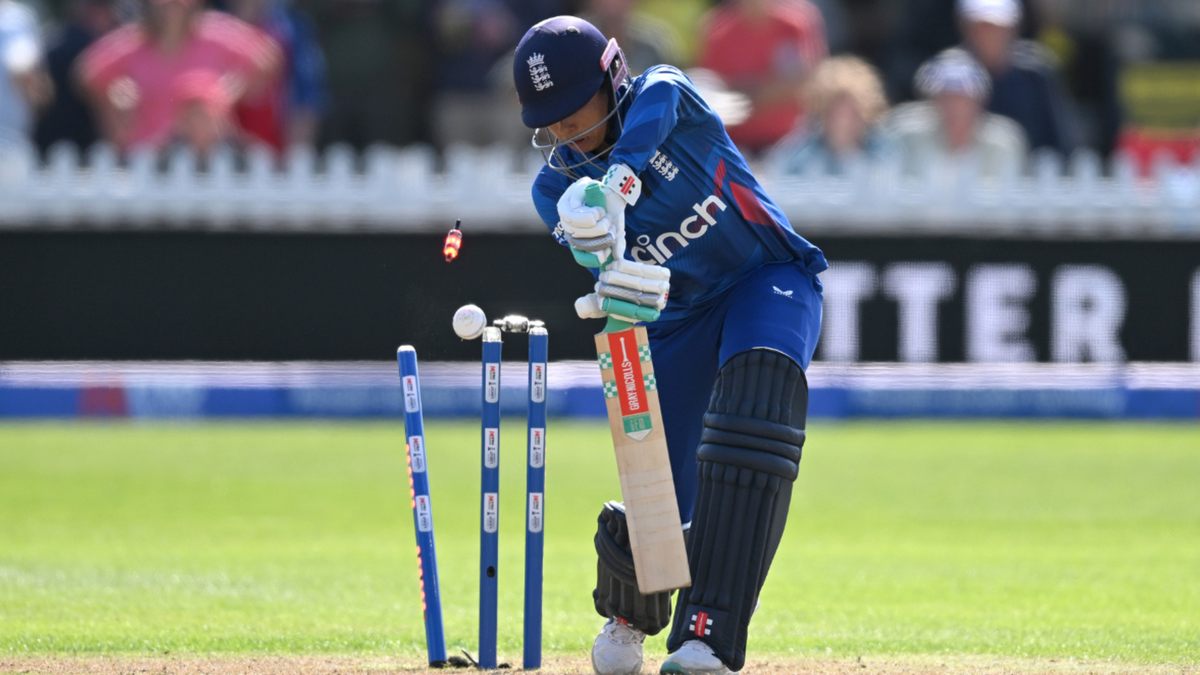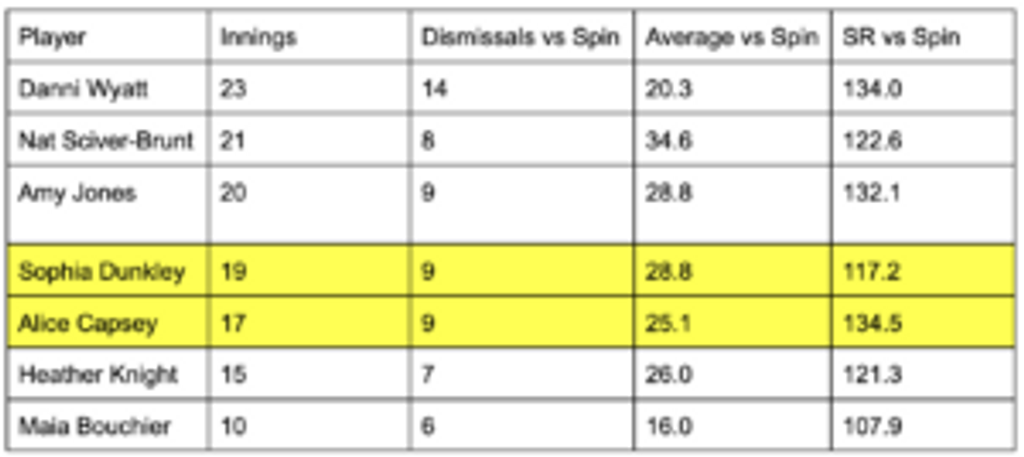
Katya Witney speaks to those in and out of the England Women’s set-up about how they can address their struggles playing spin bowling.
Subscribe to the Wisden Cricket YouTube channel for post-match analysis, player interviews, and much more.
England go into their first tour of India for four years off the back of a contrasting summer.
Having beaten Australia in the ODI and T20I legs of the Ashes for the first time in 10 years, they were undone by Sri Lanka in a T20I series for the first time ever. Central to that loss were the 18 wickets that fell to spin across the three-match series.
Across all formats over the 2023 summer, 64 per cent of England wickets were taken by spin bowlers. With the T20 World Cup set to take place in Bangladesh in less than a year, how they address that apparent weakness in their upcoming series in India will be an important step in their run-in to the competition.
Speaking after their loss to Sri Lanka, Jon Lewis acknowledged the difficulties spin had posed during the series. “Off the back of the Ashes, and from what I saw in the World Cup, it’s pretty clear that the way we play spin bowling is a big area of development for us,” he said.
“We’ve got a 20-over World Cup in Bangladesh, we’ve got a tour to India and we’ve got a 50-over World Cup in India. So our next three big challenges in reality, there’s going to be a lot of spin bowled at us. People will watch us play spin and they’ll go, ‘right, okay, we think we can exploit this team in that area’.”
England’s weakness against spin was exposed by Sri Lanka in devastating fashion, but it has been bubbling under the surface for some time. In all but one of England’s five defeats over the 2023 summer, spinners claimed the Player of the Match awards. Ash Gardner took 12 wickets during the Ashes Test before Alana King took three in the defeat at the Ageas bowl – dismissing three of England’s top five batters – which put the Ashes beyond their reach. Chamari Athappaththu took the honour in both Sri Lanka’s wins, with their spinners taking the top three wicket-taker spots in the T20I series.
England’s issues go back further. Since the start of last year, their average against spin is middling to poor – sitting fourth in the world in T20Is, and fifth in ODIs.
How they can improve this matters now more than ever. Their calendar is packed with subcontinental tours and World Cups set to be hosted in Asia, each tournament another marker in whether the ‘gap’ to Australia has closed or expanded. The Aussies’ top six have averaged almost double what England’s have against spin in T20Is over the last two years – it’s a clear point of difference. After the T20 World Cup in Bangladesh next September, the 12-month countdown clock will start to the ODI World Cup in India.
In theory, with the No.1 ranked ODI and T20I spinner in their arsenal, and an exciting pack of fast bowlers, the upcoming schedule offers England an opportunity. But they risk squandering it if they continue to fall short of where other sides are at in their batting against spin bowling.
***
England’s batting since Jon Lewis took over as head coach in December last year has been characterised by aggression. Since he took charge, their overall run rate in T20Is has gone from 7.45 in the two years before his appointment to 7.84 since. It’s a similar trend in ODIs, where their collective run rate has gone from 5.00 to 5.33.
This also shines through in their strike rates playing spin where, despite sitting fourth in the average standings in T20Is, their top six’s collective strike rate over the last two years is 122.3 – second only to Australia’s (141.6). In ODIs, their strike rate is almost identical to Australia’s at 89.7 and 91.2 respectively.
While the attacking mindset instilled in the side by Lewis and a new generation of young, franchise-honed batters has allowed them to play an enterprising brand of cricket, the tour to India will be a different challenge. All three of the T20Is will be played at the Wankhede, while the Test match will offer a four-day spin examination. Getting that balance between attacking and being able to rotate the strike and score consistent runs against spinners is where England have been found wanting.
“If you look at the way England approached this summer, they were obviously aggressive and looking to move the game forwards all the time which I fully support,” says Lydia Greenway. “But I feel like that led to them at times perhaps not being as smart as they could have been, especially against spin where, to be effective, yes you need to be able to blast the ball out of the ground but there’s also a time and a place for a bit of grit and determination. The women’s game is so dominated by spin, so they know they’re going to face a lot more of it, especially in India.”
It’s an assessment Mark Butcher, who watched England’s struggles against Sri Lanka closely while working for Sky Sports, agrees with.
“The issue was that they didn’t have any rotational shots,” he says. “It was all blocks and slogs really. If you’re not able to rotate and knock the ball in front of the wicket between extra-cover and midwicket and square-leg and midwicket, then it becomes block, block, big shot, cow corner, big sweep or trying to slog it over the top and over extra-cover.”
As well as their mindset, England’s technique is under the scanner too. “I remember in the games at Chelmsford and Derby [in the Sri Lanka series], if the ball just holds a tiny bit and you’ve got yourself too close to it, too close to off stump with the ball coming in on the angle, even if you are being hyper-aggressive you’re always playing slightly across the spin of the ball,” Butcher says.
Greenway speculates that its a lack of trust in defence that sees England go for the big shot too often: “The players in this England side, if I compare them to the era that I played in or even before then, they can do so many more things that players like myself and others couldn’t do in terms of the power hitting, being able to find the boundary much easier. But one thing you could question is the player’s defences because they don’t feel like they have to rely upon it too much.”
Whatever the diagnosis, it’s clear that England need to work on expanding their game, and they are working to correct the issue. Six batters – Sophia Dunkley, Alice Capsey, Emma Lamb, Dani Gibson, Freya Kemp and Bess Heath – flew to Mumbai in October for a spin-focussed training camp with an eye on the India tour.
[caption id=”attachment_594757″ align=”aligncenter” width=”635″] England players vs spin in T20Is since January 2022 (10+ innings only) – Highlighted players on the October Mumbai spin camp[/caption]
England players vs spin in T20Is since January 2022 (10+ innings only) – Highlighted players on the October Mumbai spin camp[/caption]
“It [the camp] was to start exploring methods and different shots and techniques against spin bowling,” says Alex Gidman, who took up a role as England assistant coach ahead of the camp in Mumbai. “We were there for five days and just faced a lot of spin. We had really good local coaches who helped us with some of their ideas and their theories and methods, and the girls just went out there and tried to apply them.
“We looked at sweeping, we looked at playing off the back foot, we looked at cutting, going over the top, exploring 360 degrees really. It was very spin focussed although there were some seamers as well.”
England remain a work in progress. Before the senior squads arrived in Mumbai this week, England A played three T20s against an India A side. They lost the opening match of that series by three runs, with five of the seven wickets claimed by bowlers falling to spin. While England A eventually won the series 2-1, nine out of the 11 England wickets that fell in the remaining two matches were also taken by spinners.
The task in India will be tougher than ever. In their squad for the senior series, India have included young stars from the U19 World Cup and the first edition of the Women’s Premier League. As yet uncapped Shreyanka Patil was the highest wicket-taker in this year’s Women’s Caribbean Premier League with her quick off-breaks. Left-arm finger-spinner Saika Ishaque, also uncapped in senior internationals, was the second-highest wicket-taker in the WPL. The message from Gidman is that England need to balance success now with instilling the right mentality for the future.
“We’re expecting conditions to be challenging,” says Gidman. “So for the management and the leadership, putting these players in positions that I would call high pressure and high stress is with that bigger picture outlook. It’s a bit about now, but looking forward as well.
“Obviously, we are the England cricket team and we want to win now, but equally there’s not a fear of trying to grow as a team and as individuals. Yes okay, that may come at a bit of a cost occasionally right now. We’re not intending for that to be the case but there’s an understanding within the group that that may happen and we are building towards that World Cup.”
For England, the next two years start now. Unless they can solve their spin issues, they will come up short again. But if, by the end of this subcontinental stretch, they are world champions again in at least one format, they may look back on this tour as providing the foundation for that success.








